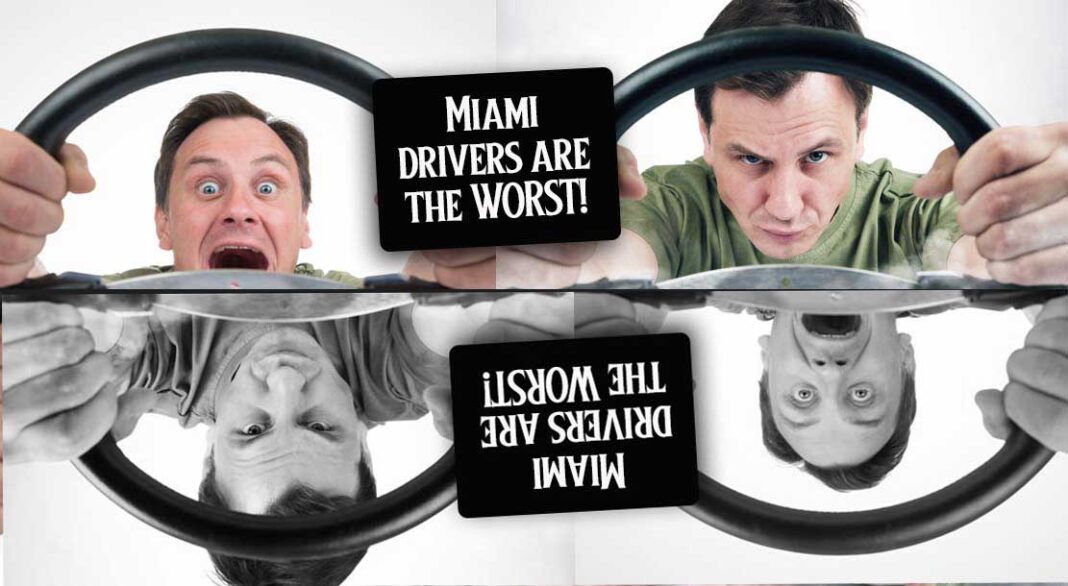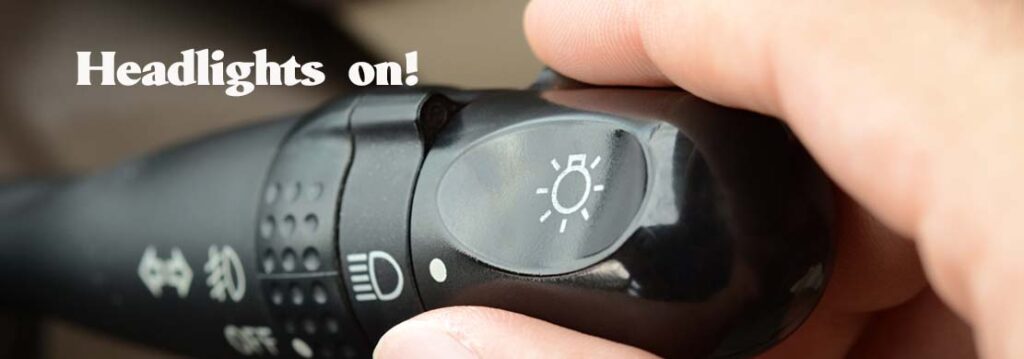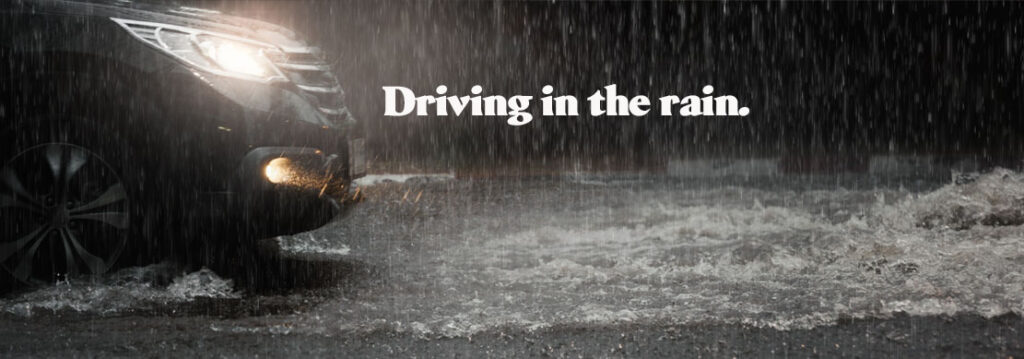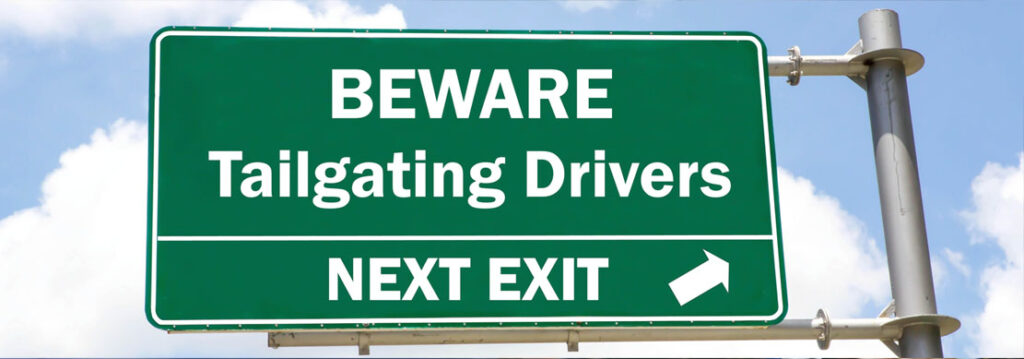For anyone who drives in Miami, it’s obvious. Stating that Miami Drivers are the Worst is not breaking news. It’s no surprise. Unfortunately, its’ so bad, we’ve grown numb to the absolute morons that share the road with us. Make sure you wear your seatbelts because we’re sharing the road at life ending speeds with a swarm of complete idiots who all have a Florida Driver’s License.
TURN ON YOUR HEADLIGHTS
Is it too much to ask that you put your freaking lights on when driving in the dark? It used to be a rare phenomenon to run into someone driving with their lights off. Now, you can spot them on a nightly basis. Did COVID all the sudden make people oblivious of the fact that they’re driving without their lights on?
There’s nothing worse than changing lanes at night on a highway only to realize that there’s an absolute imbecile in the lane you’re about to change into driving with their lights off. Do they not know how hard it is to see vehicles in your mirrors at night if they have no illumination? At least if the car is in front of you, the rear tail lights provide a reflective surface. But when they’re behind you, all you might be able to pick up is a silhouette in your mirror…if you’re lucky.
And then you have the simpletons who are driving around with their DRLs. (DRL is an acronym for Daytime Running Lights.). DRLs are lower powered headlights. They don’t illuminate as much as your standard headlights. Oh, and if you’re driving with just your DRLs, it means your taillights are off. In other words, you might be culpable if someone rear ends you if you only had your DRLs at night.
Why are so many more people driving with their lights off? In the pre-digital olden days, you could easily tell if your lights were on or off by your dashboard. The analog backlight that allowed you to see your speedometer and RPM gauge would not light up unless you turned on your lights. In other words, you were most likely drunk or falling asleep if you drove off and didn’t realize it was tough to read your speedometer….since your lights were off!
Today we have digital instrument clusters that have become LCD displays. They have fancy animations when you turn them on. Some of them are complete works of art that dazzle you. From a practical standpoint, the modern instrument cluster now shares a whole lot more information about your car. But today, your instrument cluster is always lit up. And yes, there’s an idiot light to let you know that your lights are on. But frankly, it’s not effective at telling a bunch of idiots that the lights aren’t on.
Let me put it another way. In the old days, your exterior lights were off, your instrument dashboard lights were off. Today, your exterior lights are off, your instrument cluster is on no matter what.
Automatic technology headlight technology already exists. I’m not a big government mandate guy, but with the amount of fools who drive around without their lights off, I’m convinced we’ll never fix stupid. So, thanks to stupid, we’ll need to mandate that new cars all come standard with automatic headlights that you’ll no longer be able to control on your own. Sorry. That’s what happens with stupid people.
FLORIDA LAW: WHEN TO TURN ON YOUR LIGHTS
From Section 316.217
(1) Every vehicle operated upon a highway within this state shall display lighted lamps and illuminating devices as herein respectively required for different classes of vehicles, subject to exceptions with respect to parked vehicles, under the following conditions;
LEARN TO DRIVE IN THE RAIN
Here are the simple steps you need to do when it starts to rain in South Florida.
- Slow your speed based on the weather and road conditions.
- Turn on your windshield wipers
- Turn on your headlights (if you’re confused about this, go back to the begging of this article)
- Increase the distance between you and the car in front of you
- Drive carefully
- Don’t drive in unfamiliar roads covered by water (lest you end up in a canal)
- Don’t slam on your brakes (hence rule #4)
That’s it. That’s all you have to do. But of course, we live in Miami where people are special. You’re in a full on summer afternoon downpour. The sky is completely black. Visibility is limited and you’ve got a come mierda driving with their lights off. (Refer back to the beginning of this article.). Oh…my….Goodness….When it’s raining visibility sucks. It’s hard enough seeing in front of you. It’s even harder identifying vehicles in your side view mirror through a downpour, through a side window covered in beads of water, on a mirror covered with water, and the guy in the next lane is driving with their lights off. How are you supposed to see them? For the love of driving, friggin turn on your headlights when it’s raining.
Then, you have people driving like Mario Andretti in the rain. Are you kidding me? Ever hear the phrase “slippery when wet?” When it rains, it’s time to slow down. The amount of rain, traffic, visibility, and road conditions dictate the amount of speed reduction required to drive safely. For example, if you’re driving on I-95 after a downpour and the road is extremely shiny, it’s likely a concrete road which is far more slippery than a typical asphalt paved highway. In fact, many of you know that I-95 was retrofitted with rain grooves cut into the concrete because it was so bad for so many years. It’s better, but it’s still not great.
Concrete roads are all around us and they are very slippery and dangerous when wet. Nearly every overpass in Miami has a concrete section. When wet, you’ll notice it shines differently than an asphalt roadway. That shine means the road is more slippery and deserves more precaution.
On the other hand, we do have some great roads. Portions of I-75 in Broward drain beautifully. It’s a modern highway better designed to pull water off the roadway. Thus, it has less of the shiny sheen even during sever downpours. This doesn’t mean you should drive faster when it rains. It just means the conditions on this road are safer than some other, more dangerous roads.
By the way, when it’s raining, your car needs tires with good treads. Tires with great treads can hydroplane (lose contact with the road surface as the tire “surfs” over the water) if you’re going too fast. The less tread you have, the more likely you are to hydroplane. And yet we have hundreds of drivers that take on Miami’s roads with bald tires. In addition, to being illegal, it’s very dangerous, especially on the highway. Hydroplaning can cause the car to spinout. This is not only a danger to the driver and the occupants, but also to everyone else on the roadway.
Finally, you don’t drive a submarine. Your car needs oxygen in its engine. Every year we have some flooding in some part of town. It could be downtown Miami, Miami Beach, Sweetwater, Kendall, etc. It doesn’t matter. There are drivers that will drive through water their car can’t handle. Before you know it, the car has stalled due to water getting into the intake and the car is dead. Usually, the vehicle will end up as a complete loss.
One more thing about driving through flooded streets. You can’t tell where the road ends and where there’s a canal. We’ve seen this countless times. Don’t drive through flooded streets you’re not familiar with. There’s a serious risk of killing yourself and the occupants of your vehicle.
Key takeaways for driving in the rain:
- Make sure you have good tread on your tires
- Slow down
- Turn on your headlights
- Don’t drive through flooded streets if you’re not familiar with the area
I OWN THE ROAD
Many Miami drivers drive on the road with the following philosophy I can best describe in Spanish: “Quitate tu que vengo yo.” That translates into “get out the way, ’cause here I come.”
You’re driving. You’re in your lane. You’re minding your own business. That’s all you need to do to have a random driver cut you off. And then they get upset, because you were in their way. REALLY?
One of my favorites is the Miami mentality that I’m too special to wait my turn. We see this ALL…THE…TIME. You’re in a line of cars a quarter mile long. Then you see that driver that’s too special. They can’t wait like everyone else. Their mom told them they were special. So they can’t patiently wait like everyone else who’s in the lane. They’re too special. They are going to pass everyone who’s patiently waiting and nudge their car close to the front of the line. Meanwhile, this particular driver could care less that they are blocking a lane of moving traffic. It doesn’t matter. They really don’t care. This “line skipper” is too special to wait like everyone else. They have special Miami permission to pass everyone. And then block everyone behind them that are trying to use this free lane to continue moving forward.
This particular driver lacks any respect for anyone else as they see themselves as special and better than all the peons who share the road with this member of Miami road royalty. This particular class of Miami road royalty does not discriminate. This royal class includes male and female drivers. This royal class includes members of all races and ethnicities. And they can be driving a nice BMW or a used Hyundai. So in that sense, this royal class may disrespect you, but they are equal opportunities disrespecters that don’t discriminate based on age, gender, income, race, or ethnicity.
Within the category of “I own the road,” there’s the intersection blocker. This is the person that can’t clear the intersection and will sit their car in the middle of the intersection. The light changes and they are blocking one to two lanes of cross traffic that have the green light. You know why. Because they are too important to wait another light cycle. The needs of this driver is far more important than anyone who has to wait for this driver to clear the intersection. The line of cars that have the green light now have to wait until this selfish driver clears the way. To be fair, these intersection blockers really fall into two categories: The selfish driver who doesn’t care who they block and the ignorant, totally unaware driver that is so stupid, unaware, or cognitively impaired, that they don’t even realize that they haven’t cleared the intersection and that they will be blocking traffic when the light changes.
Of course, under the category of “I own the road” comes the road warrior. This is the man or woman who comes up behind you and rides your rear end. Also known as the infamous tailgater, they are every where. Forget the fact that you may need to brake suddenly. Forget the fact that the tailgater will not have enough time to stop before they hit you. In fact, rear end collisions due to tailgating is one of the leading types of accidents in South Florida.
There are two ways to tell if you’re following too closely. One is the 2 second rule. It should take a minimum of two seconds between the time a car in the lead passes any point on the road and the time the car following passes the same point. In other words, if the car in front of you passes a sign on the highway and you pass the same sign in less than 2 seconds, you are following too closely.
The other way to tell if you’re too close is based on the number of car lengths between you and the car in front of you. This is the 10mph rule. For every 10 mph you’re doing, you should have one car length in between you and the car in front of you. If you’re doing 30mph in a residential neighborhood, you should have a separation of 3 car lengths in between you and the car in front of you. If you’re doing 70 mph on the Turnpike, you should have a minimum of 7 car lengths between you and the car in front of you. Of course we know that is far from the reality we see on the roads each day, but that is the proper safe distance.
Tailgating is stupid. There is no benefit to tailgating. Tailgating is stressful for the person tailgating as you need to be very aware to instantly react to the driver in front of you. Of course, it can also be stressful to the person in front that is now fearful of stopping quickly to avoid getting rear ended. Here are some of the reasons tailgating is completely idiotic:
- Reduces response time to milliseconds
- Significantly increases risk of rear end collision
- Increased liability Risk
- The person following is responsible for the rear end collision nearly 100% of the time with the rare exception being able to prove someone cut you off and then caused the accident (we highly recommend driving with a dashcam to prove this in court)
- You not only have to repair your vehicle, but that of the vehicle in front of you.
- Reduces visibility
- You’re ability to see around the vehicle is inhibited by the vehicle in front of you.
- Back off and you’re visibility increases significantly.
- Slows you down
- You can’t accelerate when tailgating or you’ll hit the vehicle in front of you.
- However, if you have space between you and the car in front of you, then you can accelerate, if necessary, to change lanes if needed.
- It’s illegal
- I know…traffic laws are treated like suggestions in Miami and not actual law
- But you can get pulled over for tailgating…yeah…yeah…I know it’s rare, but it is can also be considered reckless driving.
Florida law on tailgating:
316.0895 Following too closely.—
Now, despite all of that, you still have Mad Max…the road warrior…that will come up behind you on the left lane at 70mph with only 3 feet separating vehicles. The intimidator. Forget the fact that it’s a college girl driving a Jetta. She’s going to make sure her presence is felt. Of course, it doesn’t matter that the speed limit is 55 mph and you’re already passing everyone on the right lanes. This road warrior wants to go even faster. And you…Yes…You…are…in…her…way. She’s the intimidator and she’s going to tailgate you until you speed up or move out the way. Of course, she’s going to get off at the next exit, but until then, she’s in Ludacris mode: “Move bitxx, get out the way…get out the way…”
One final thing I’ve noticed about these tailgaters. They are chicken. I find that tailgaters will tend to get really close to vehicles of similar size or smaller. In other words, you don’t see that many tailgating a semi-rig. In reality, tailgating a semi is far safer than say tailgating a Miata. A Miata will stop on a dime. In other words, you need to give it space to stop. A big rig needs a lot more real estate to stop. I find this true with my F-150. Few will tailgate me despite the fact it takes a while for my truck to stop. But if you’re driving a Mini, you know people love to tailgate despite the fact that the Mini also stops on a dime.
ROLLING STOP SIGNS IN MIAMI
Stop signs used to mean something. You were supposed to come to a complete stop. Check for traffic. Then proceed once the traffic is clear.
Today, stop signs are more like suggestions you should slow down. Almost like a yield sign. This is incredibly dangerous as it can has lead to the deaths of pedestrians.
Here’s what so many Miami drivers do. They’ll approach a stop sign looking to the left. The driver wants to make sure no vehicle is approaching from the left. If no car is coming, the driver will slow down to make a right hand turn, but not come to a complete stop. However, since the driver is only looking towards the left, they fail to see potential dangers on the right. This includes pedestrians crossing an intersection, bicyclists, dogs, a vehicle, etc. This is part of the reason why Florida leads the way in pedestrian fatalities.
316.123 Vehicle entering stop or yield intersection.—
VIDEO: BAD DRIVERS OF MIAMI
Nothing makes my point of bad Miami drivers than actual video. So here you go:























